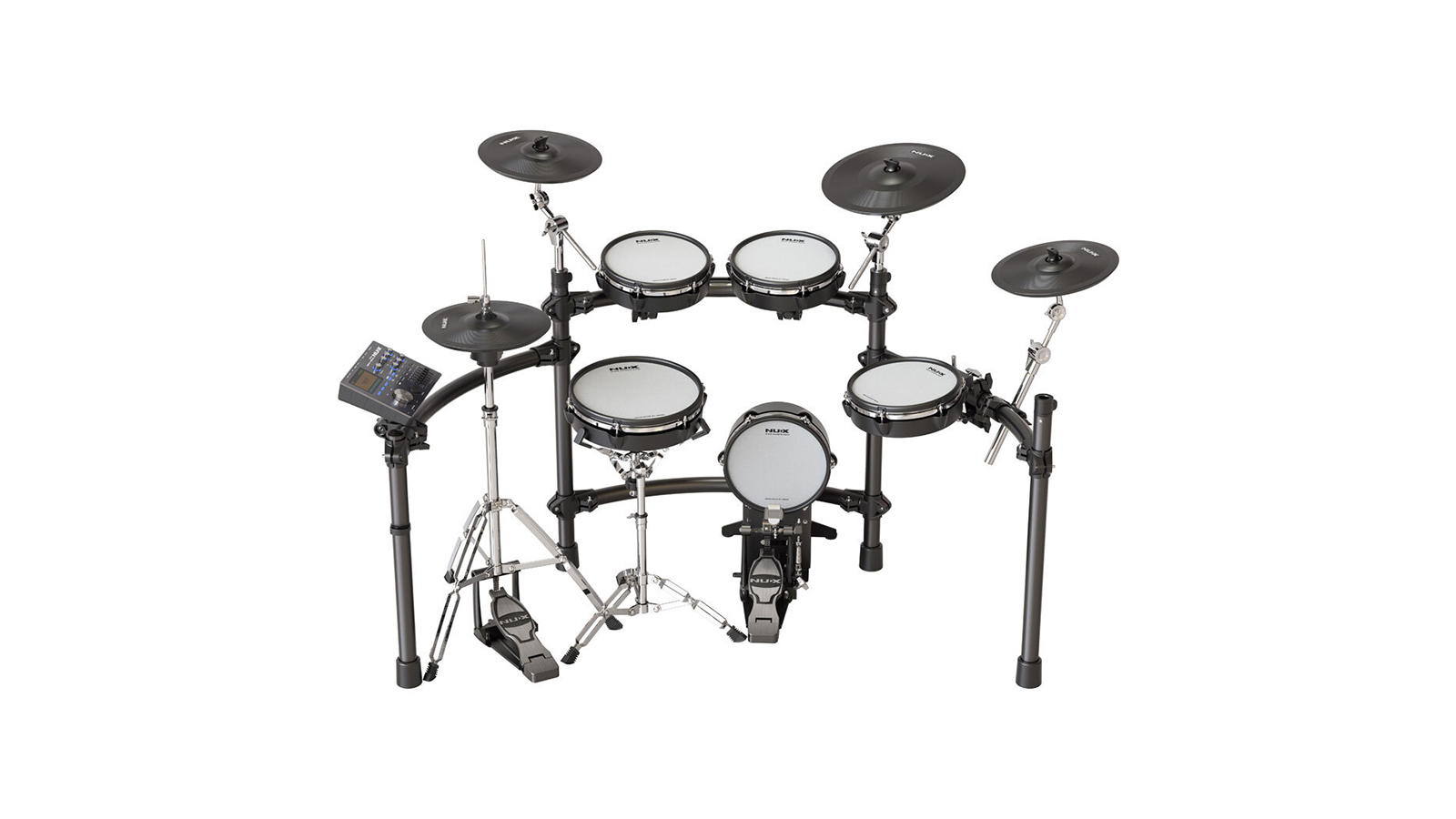MusicRadar Verdict
NUX’s new flagship kit takes all the best bits from the competition - responsive Remo mesh heads, a spacious, curvaceous rack and a trick module - and combines them into a great-looking, great value electronic drum set package. While the stock sounds won’t win any awards, there’s plenty of customisation to appease all but the most pedantic of drummers, and additional features such as Bluetooth, sample import and USB recording more than make up for any minor shortfalls. Overall, this is a tough kit to beat.
Pros
- +
Amazing value package
- +
Large adjustable rack
- +
Responsive Remo mesh heads
- +
Easy to setup
- +
Bluetooth
Cons
- -
Room for improvement with the on-board sounds
- -
Not the best option for small spaces
- -
Saving kit customisations is a pain
MusicRadar's got your back
NUX DM-8 review: What is it?
For a long time, the Big Three electronic drum set brands Roland, Yamaha and Alesis stood alone. Drummers looking for a lower-volume home practice tool typically bought a kit from one of these brands. But recently that choice has grown significantly with EFNote, Pearl, GEWA, Donner, and now NUX stepping into the fold. NUX (pronounced ‘new x’) is best known in guitar circles for their affordable amps, effects, wireless systems and more, but we’re here to see how their e-drums measure up against growing competition.
The DM-8 is the flagship electronic drum set in NUX’s five-strong kit line-up - you may remember Alesis launching a kit called the DM8 many moons ago, but there’s no connection and that kit is discontinued. We reviewed the beginner-focused DM-210 and mid-range DM-7X recently, while the DM-8 is aimed at players who consider themselves intermediate or higher, or fully-committed beginners with a healthy budget who want a kit they can grow into.
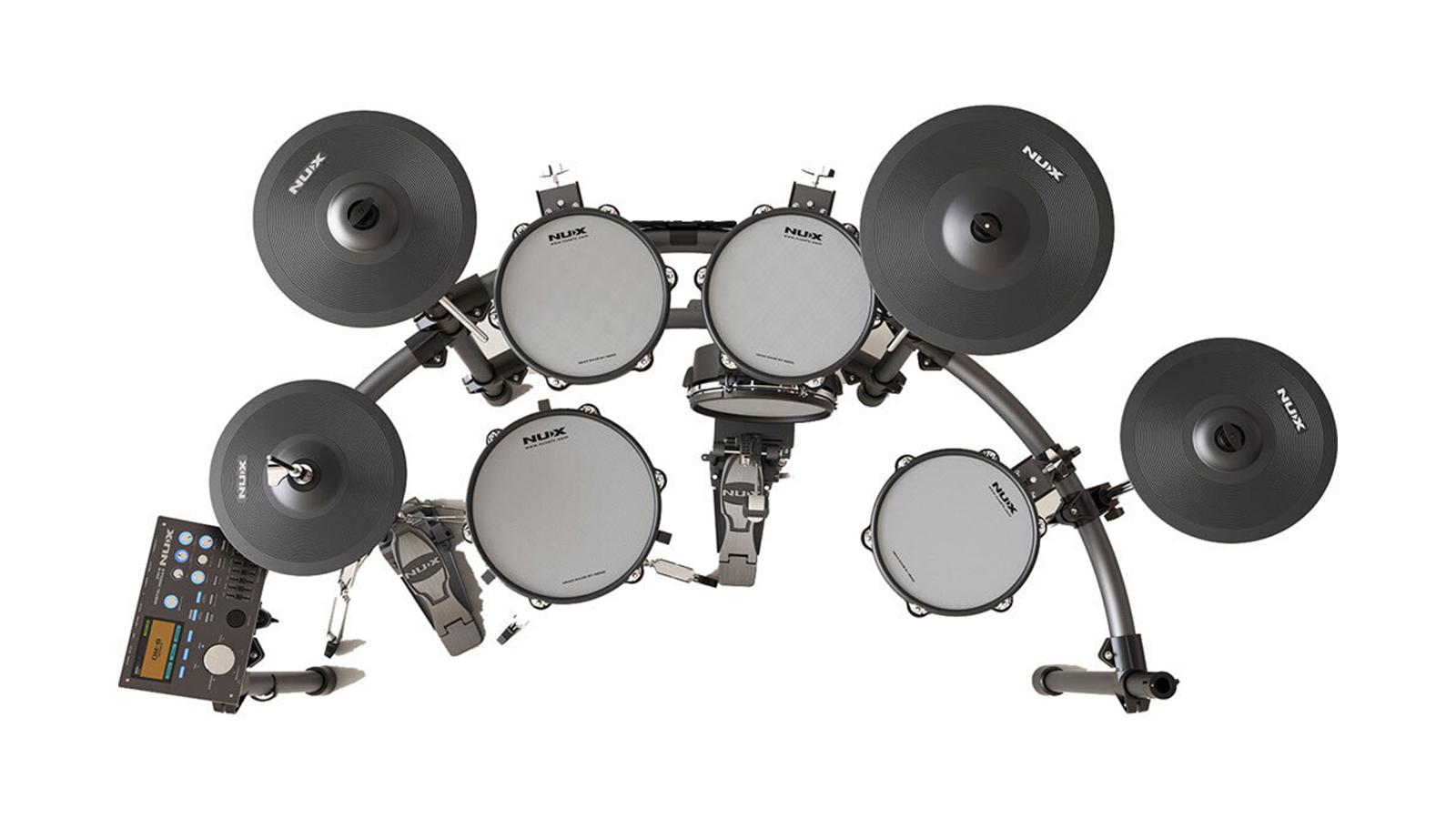
There are plenty of features we’d consider ‘pro’ on this kit, including ‘made by Remo’ mesh heads across snare, tom and kick drum pads, a hi-hat pad and controller that sit on a supplied stand for a more realistic playing experience, and a 12” triple-zone snare pad that sits on a stand (also supplied), plus a robust four-post rack.
The DM-8 module has the look of a top-end unit and comes complete with a vivid TFT LCD colour screen and built-in Bluetooth for connecting a tablet or phone. You'll also find physical faders for each part of the kit on the front of the module for easy mixing on the fly.
The three toms pads are 10” and dual-zone, while the bass drum tower is also 10” and provides plenty of real estate for a double pedal. A single bass drum pedal is supplied in the box. The kit is completed by two 12” dual-zone/chokable crashes and a 14” triple-zone ride cymbal. It’s a pretty compelling package out of the box and the module even has the capacity to be expanded by an additional two pads should you need an extra cymbal, auxiliary snare etc. But for most drummers, there's not much you won't be able to achieve with this configuration from day one.
NUX DM-8 review: Performance & verdict
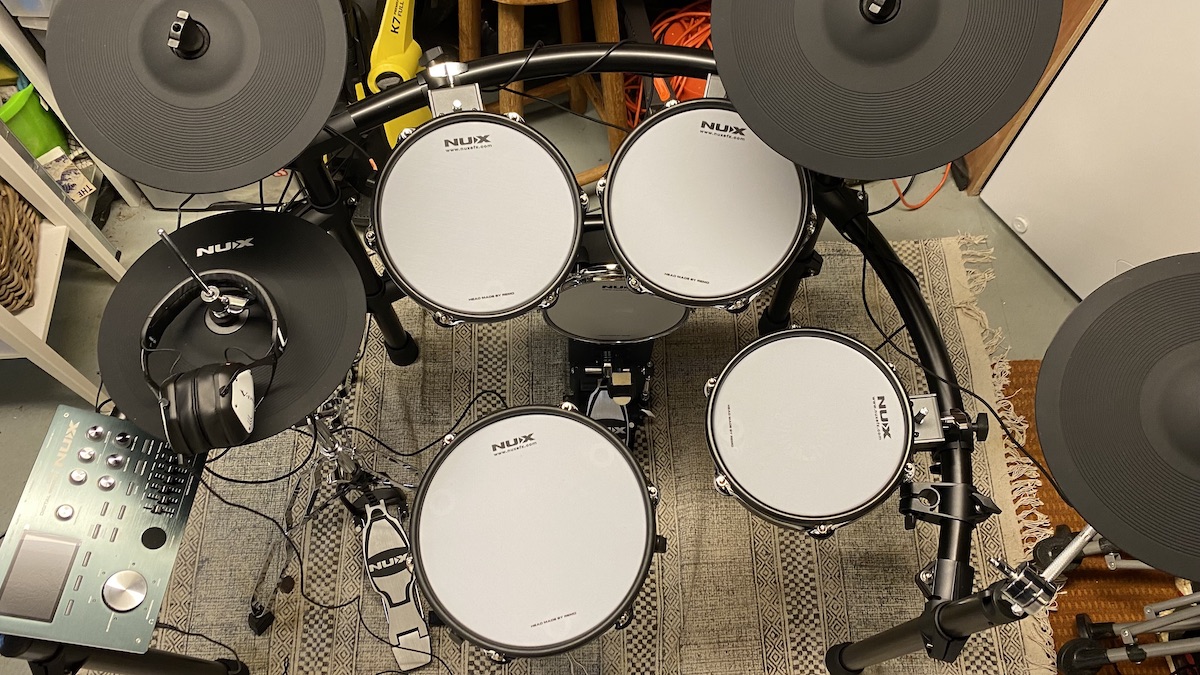
Setting up the kit
The DM-8 was delivered to us in just two boxes; one containing the rack system, plus cymbal and tom arms, and the other housing the pads, stands, bass drum pedal and module. Our kit also came with two drum keys, hex keys for pedal adjustment and a pair of flimsy looking branded drumsticks which, honestly, we’re unlikely to use. Except for a throne and headphones, you really do get almost everything in the box to start playing right away.
Setting up an e-kit can be hit and miss, from total pleasure to total nightmare. The time from opening the boxes to playing our first beat on the DM-8 was around 80 minutes. We’ve set up a lot of e-kits over the years and believe us when we say this is good going. Packaging was neat and everything clearly labelled. The DM-8 rack arrived with clamps pre-installed at the factory, leaving us to simply slot the tubes together - internal guides ensuring a solid connection with no unwanted rotation - and tighten everything up. A huge time-saver.
In our experience, racks on cheaper kits can be tricky to get level and are prone to wobbling, meaning you spend as much time adjusting as you do playing. The DM-8 rack is reassuringly planted thanks to four vertical posts, and four horizontal curved bars that are easily adjustable, no matter how uneven your floor is. With such a rock solid foundation, placing and positioning the pads and module is easy too. This kit gets extra kudos for the quick release arms at three of the vertical rack posts for adjusting cymbal height and locking cymbal arms in place.
The rack itself is pretty big too. It’s spacious enough to accommodate the large pads, the stand mounted snare and hi-hat stand, without feeling cramped or compromised. If you're short on space it's worth noting that this kit has a reasonably large footprint.
As with most e-kits, pads are connected to the module via a single connector at one end of the supplied cable loom. At the other end are labelled ¼-inch connectors for each pad. Connecting everything up is quick and painless. Inevitably you end up with a mess of cables running the length of your rack, so internal cable routing would have been a nice addition, but for the price you have to expect a bit of corner cutting.
Finally on the hardware front, the supplied branded bass drum pedal and hi-hat stand won’t win any awards for design or features, but they don’t look cheap and are perfectly functional. The snare stand does the job, but would be the first thing we’d upgrade.
The pads
In our opinion, mesh pads are the only way to go when it comes to electronic drums - they're the closest thing to an acoustic head and can also be tensioned enabling you to dial in the rebound and response that works for you. These ‘made by Remo’ mesh heads are no exception and feel just like the heads you’d play on any mesh-headed Roland kit. Each pad is surrounded by a chunky rubber rim that makes light work of rimshots or cross stick.
Cymbal pads are all rubber and look great adorned with an understated NUX logo. So far we've not left any significant stick marks on the rubber, so they should stand the test of time. Pads feel forgiving under stick and, thanks to an anti-rotation attachment on the cymbal arm, they stay in position so you’re always striking the sweet spot.
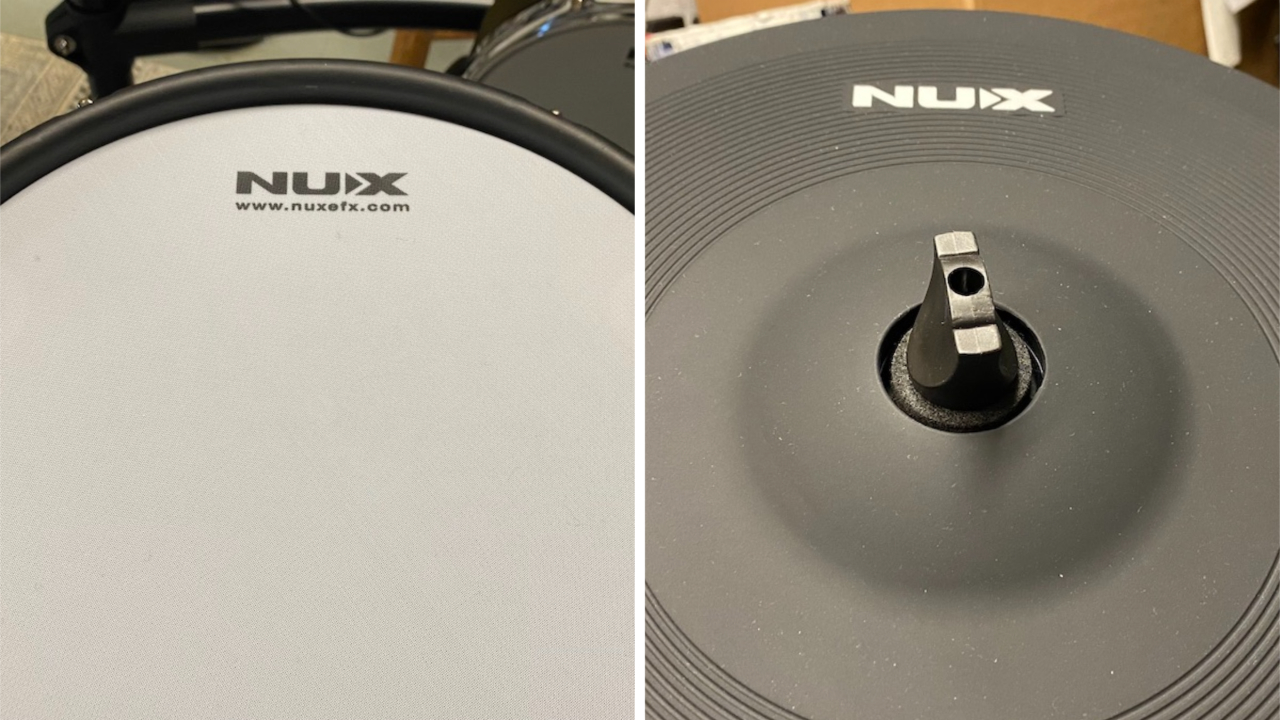
The triple-zone hi-hat pad is a joy to play and there’s a lot to be said for the direct connection between pedal and cymbal when mounted to a proper hi-hat stand, as opposed to having a separate pad and controller pedal.
In terms of the audible pad sound in the room, they aren’t noticeably louder than any competitors. By the very nature of a wooden stick hitting a surface, you’re never going to have a completely silent electronic drum set, but mesh heads certainly do a decent job of suppressing some of the noise.
The tom, snare and bass drum pads feature three triggers apiece, spread out in a triangular shape beneath the head. Rolling from edge to the centre of each pad produces a consistent and pretty dynamic response, so there’s certainly capability to replicate the nuances in your playing, from the subtlest ghost notes to the fattest backbeats. So far in our testing we’re yet to experience any mis-triggering or hot spots.
The module & sounds
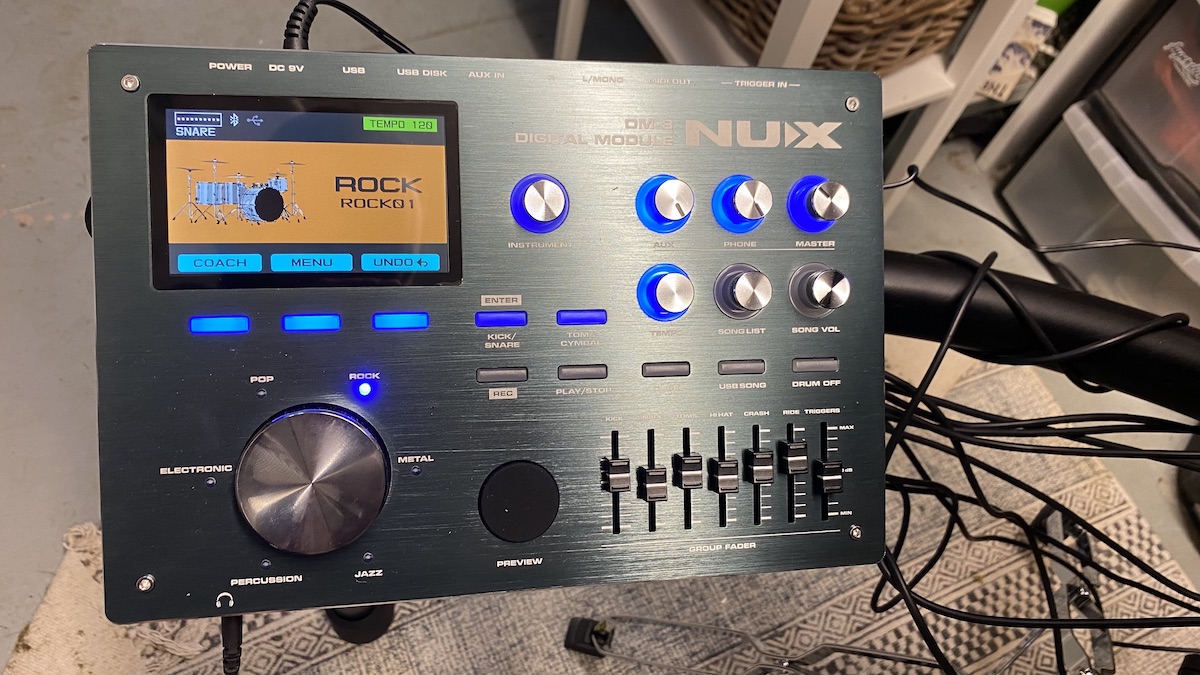
So, it’s safe to say we’re big fans of the hardware, but what about the module, the centrepiece of any e-kit?
The DM-8 module earns style points for the lush LCD colour screen and industrial-looking brushed metal faceplate - drum brands take note: not everything needs to be black. There’s a very familiar rotary wheel to the bottom left for selecting kits, split by genre - rock, metal, jazz, percussion, electronic and pop - with a total of 48 kits. Rotate the wheel to the desired genre, then press the wheel to start scrolling through the eight preset kits for that genre. We first saw this approach to kit selection on the Roland TD-25KV in 2015. Back then we liked this method and the economical selection of kits, so we’re not mad to see it resurrected here.
The module also features a full complement of faders assigned to each part of the kit for easy-access mixing on the fly. We found this particularly useful when we were jamming to songs and needed to duck the snare a touch, or bring the hi-hats up in the mix. Menu diving to change levels when you’re in the middle of a playing session can really interrupt your flow.

Roland TD-17KV2
Yamaha DTX6K2-X
Alesis DM10 MkII Pro
There’s Bluetooth on-board the DM-8 module, too. Honestly, we’re still blown away that drummers can now wirelessly connect a tablet or phone to a drum module to access tracks or video lessons. E-kits already have more than enough cables to contend with, so we're firm supporters of ditching the aux cable.
So, we have some killer hardware and some neat tech touches, but what about the sounds? The DM-8 module contains a handful of really great kits that we would gladly play for hours: Rock01 and 02 have power, punch and presence, while Jazz03 is a funky little number. Some of the electronic kits were surprisingly fun to play too and sounded impressively fat. But many of the kits fell short, either because they were lifeless, unnatural or over-processed.
Thankfully there’s plenty of customisation possible in the box, whether that’s swapping kit parts out completely, assigning different sounds to head and rim on the multi-zone pads, or spicing things up with effects such as reverb and overdrive. You can also delve into individual pad and master EQ to really dial in the sound you want. We found navigating the menu screens a little fiddly at first, but it gets easier the more you do it and we produced some great sounding kits after some patient tinkering.
Frustratingly there are no dedicated user kit slots to save a completely bespoke kit. Instead you can edit one of the 48 existing kits and rename it - we guess NUX feels the kit offering is strong enough that you’ll use one of theirs as a base for your own creations. Regardless, we wanted to build a kit from scratch so opted to override one of the less desirable kits that we weren’t going to miss.
And this brings us to another gripe with the module. Before you make changes to various parameters, you need to remember to unlock the module, then make your changes and lock it again. If you don’t, the next time you power down all your changes will be lost. This happened to us more than once…
So, the module has its niggles and the sounds aren’t the best out there, but there’s plenty of adjustment available to help you zero in on a sound that works in the box. But let’s be honest, how many people buy an e-kit to use as MIDI controller for recording straight into their DAW, or for triggering sounds through Superior Drummer or Addictive Drums? It’s probably far more than you think. We found mapping the DM-8 to Superior Drummer 3 a breeze and triggering sounds from the Rock Foundry package absolutely transformed the kit.
So, when you have this capability at your disposal - at an additional cost, granted - does the quality of sounds in the module really make a kit? We don’t think so, but if on-board sounds are a genuine deal breaker, we’d suggest you look to Yamaha and Roland who excel in this area.
Other cool features of the module include the ability to import your own sounds via USB, enabling you to create completely custom kits. Perhaps you want to play the kit live and want the snare sound straight from your band’s EP? Or maybe you want to add a hand clap to the rim of the snare for a particular track? That's all totally possible.
If you want to record yourself playing, the DM-8 delivers a couple of methods: record direct to a USB stick to quickly capture an idea, or connect to your DAW of choice and your module acts as your audio interface, enabling you to record up to 14 separate audio tracks. We found both of these processes super intuitive and we love that the DM-8 is great for recording as well as a fantastic practice and jamming tool.
Verdict
So, where does the DM-8 sit amongst the heavy competition at this mid-range? With a retail price of $/€1,549, this kit sits fairly level with Roland’s TD-17KV2, but this model doesn’t include a hi-hat stand or kick pedal, and there’s no second crash. The Yamaha equivalent is the DTX6K2-X. While this kit has a superior module loaded with market-leading sounds and includes a hi-hat stand and second crash, the tom pads are rubber which we’d avoid at this price point. The Alesis DM10 MKII Pro is the closest you’ll get for value, coming in at just a shade under $/€1,500 and delivering 10 tom and cymbal pads, plus a stand mounted snare pad, but there’s no stand-mounted hi-hat here.
The point we’re making is that, if your budget is around $1,500-$1,600, there really aren’t many choices out there that can beat the NUX DM-8 for value for money and features right now.
Time will tell whether NUX gear stands the test of time and earns the brand the sort of reputation that Roland and Yamaha enjoy, or whether they can unseat Alesis in the value stakes. But for right now the NUX DM-8 is a great looking, well appointed e-kit that has the potential to dominate the mid-priced, intermediate space.
NUX DM-8 review: Hands-on demos
NUX
65 Drums
LBS Music World
NUX DM-8 review: Specification
- Pads: 1x 12” snare pad (3-zone), 3x 10” tom pads (2-zone), 10” kick drum pad built into a standalone tower, 12” hi-hat, 2x 12” crashes (2-zone plus choke), 14” ride cymbal (3-zone)
- Heads: Mesh
- Kits: 48
- Sounds: 300
- Key features: Metronome, Coach, Effects, REC, Songs, Bluetooth, USB audio, WAV import, Group fader, TFT LCD colour screen
- Ins/outs: Headphone, DV-9V, USB, USB disc, aux in, L/mono R output, MIDI out, Trigger in
- Contact: NUX
I'm MusicRadar's eCommerce Editor. In addition to testing the latest music gear, with a particular focus on electronic drums, it's my job to manage the 300+ buyer's guides on MusicRadar and help musicians find the right gear for them at the best prices. I dabble with guitar, but my main instrument is the drums, which I have been playing for 24 years. I've been a part of the music gear industry for 20 years, including 7 years as Editor of the UK's best-selling drum magazine Rhythm, and 5 years as a freelance music writer, during which time I worked with the world's biggest instrument brands including Roland, Boss, Laney and Natal.
“I used everything I knew about music”: How Green Day exceeded expectations with their most ambitious song
YouTube just added AI tools that makes musicians, library music and video editors redundant
“Every one of them said yes without hesitation": Hank Marvin and Roger Taylor have just remade a '60s classic for charity
